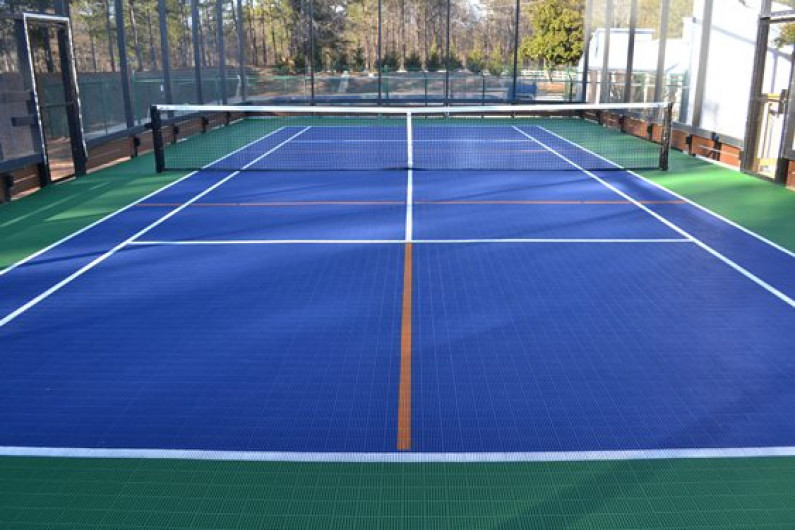Understanding the Timeline for Your Pickleball Court Construction Project
Understanding the Timeline for Your Pickleball Court Construction Project
Blog Article
Navigating Laws for Pickleball Court Building in Your Area
Creating a pickleball court in your location calls for a nuanced understanding of numerous regional policies, consisting of zoning laws, building permits, and safety and security standards. Each municipality imposes particular guidelines that can dramatically influence the feasibility of your project. Engaging with neighborhood authorities and the community is critical for making sure conformity and promoting support. Browsing this regulatory landscape can be time-consuming and complicated. What are the key steps you should think about to avoid prospective mistakes and make sure a smooth construction procedure?
Comprehending Local Zoning Regulations
When thinking about the construction of a pickleball court, recognizing neighborhood zoning laws is vital to ensuring compliance and preventing prospective lawful concerns. Zoning regulations dictate how land can be utilized and commonly consist of requirements related to recreational facilities. These laws can vary dramatically by district, impacting factors such as court placement, sound, illumination, and dimension levels.
Before starting building and construction, it is necessary to consult the local zoning board or planning division to establish the certain guidelines that use to your residential or commercial property. Certain zones might limit leisure activities, while others may call for certain licenses or adherence to particular guidelines. It is additionally crucial to think about problems, which identify just how much structures must be from property lines or various other buildings.
Additionally, exclusive advancements, such as property owner organizations (HOAs), might impose their very own guidelines regarding the building and construction and use pickleball courts. Understanding these laws can avoid costly alterations or litigation down the line. Engaging with regional stakeholders and community participants can offer beneficial insights and foster assistance for your job, ensuring that it lines up with the community's expectations and requirements.
Acquiring Necessary Building Permits
Just how does one navigate the intricacies of acquiring required structure permits for a pickleball court? The process starts with recognizing neighborhood guidelines and needs set forth by metropolitan authorities. Normally, you will need to send a detailed site strategy that outlines the suggested court measurements, products, and layout. This plan needs to follow zoning legislations and any type of particular policies referring to entertainment facilities.

When authorizations are obtained, it is vital to adhere to any type of examination schedules and demands throughout the building stage. Maintaining communication with regional authorities will promote a smoother authorization process and help prevent prospective troubles. By extensively preparing and understanding the permitting landscape, you can effectively navigate the intricacies entailed in creating a pickleball court while continuing to be certified with all local policies.

Assessing Environmental Impact
A thorough evaluation of environmental impact is essential when planning the construction of a pickleball court. This examination helps determine possible effects on regional ecological communities, water resources, and neighborhood appearances. Key variables to consider include website selection-- making certain that the court is not built on environmentally sensitive land, such as marshes or habitats for jeopardized varieties
Dirt stability and drainage patterns ought to be assessed to avoid erosion and water merging, which might negatively impact bordering greenery and wild animals. Additionally, the selection of products is crucial; going with lasting read more and environment-friendly options reduces ecological damage.
The application of reliable stormwater management techniques is one more important facet, as it helps minimize overflow and sedimentation. Engaging with neighborhood ecological firms can provide important understandings right into guidelines and ideal methods certain to your location.
Finally, neighborhood input can be useful in comprehending any type of local environmental concerns and cultivating support for the job. By performing a complete ecological impact analysis, stakeholders can make certain that pickleball court building aligns with lasting practices and adds positively to the area's ecological wellness.
Following Safety Standards
Making sure conformity with safety and security requirements is important for the successful building and construction and operation of a pickleball court. Sticking to well established safety laws lessens the risk of crashes and injuries, making certain a safe environment for gamers.
Key security standards consist of correct court dimensions, surface area materials, and lights requirements. The court needs to meet the official measurements of 20 feet wide by 44 feet long for doubles play, with ideal buffer areas to stop injuries from wayward rounds. Pickleball court construction. The surface must be constructed from non-slip check over here materials to boost traction and decrease the chance of falls
Furthermore, lights should suffice for evening play, offering consistent lighting to avoid shadows that can hinder presence. Neighborhood building regulations may also dictate details requirements for fence and net elevation to ensure player safety and security and avoid unauthorized accessibility to the court location.
Normal inspections and maintenance are necessary to copyright these standards in time. By prioritizing security compliance, court owners not only secure gamers yet additionally cultivate a favorable reputation within the community. This commitment to safety can encourage greater participation and pleasure of the sport, ultimately adding to its growth and sustainability.

Involving the Community in Planning
Area involvement in the planning stages of pickleball court building can significantly enhance the job's general success. Involving neighborhood homeowners and stakeholders fosters a sense of ownership and motivates collective decision-making, which can cause more comprehensive assistance for the initiative.
To effectively involve the community, organizers ought to start public meetings or workshops, supplying a platform for citizens to articulate their viewpoints and preferences relating to location, style, and facilities. Studies and responses kinds can additionally be made use of to gather insights from a wider audience, ensuring that varied viewpoints are taken into consideration.
In addition, creating an area advising board can assist in continuous discussions and address concerns throughout the planning procedure. This board can consist of agents from various demographics, such as web link local colleges, leisure organizations, and neighborhood watch, therefore magnifying neighborhood representation.
Reliable interaction is essential; updates about the task must be frequently shared through newsletters, social media sites, or regional bulletins. By focusing on community involvement, coordinators can cultivate excitement, reduce potential resistance, and create a pickleball center that really reverberates with regional values and demands. This collective strategy not only enriches the job but likewise strengthens neighborhood ties.
Final Thought
In conclusion, navigating the complexities of pickleball court building and construction requires an extensive understanding of regional regulations, consisting of zoning regulations, structure licenses, and security requirements. By sticking to these standards and fostering partnership, effective application of pickleball courts can be accomplished, advertising leisure possibilities and community well-being.
Constructing a pickleball court in your area calls for a nuanced understanding of numerous regional policies, consisting of zoning regulations, structure licenses, and safety criteria.When thinking about the building and construction of a pickleball court, comprehending neighborhood zoning regulations is crucial to making sure conformity and staying clear of potential lawful issues. By completely preparing and comprehending the permitting landscape, you can efficiently browse the intricacies included in building a pickleball court while remaining certified with all local regulations.
In conclusion, navigating the intricacies of pickleball court building and construction requires a thorough understanding of neighborhood regulations, consisting of zoning regulations, building authorizations, and security criteria. By adhering to these standards and cultivating cooperation, successful application of pickleball courts can be attained, advertising recreational chances and neighborhood health.
Report this page